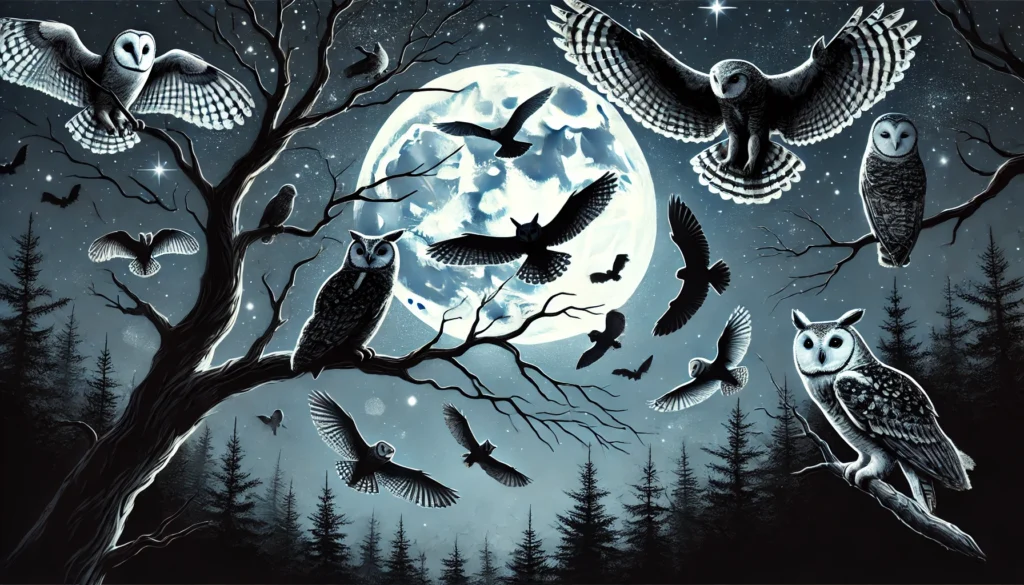Nocturnal birds possess an enigmatic beauty, emerging under the cover of darkness to hunt, communicate, and navigate their moonlit world. While daytime birds dominate the skies with their vibrant colors and songs, the night harbors its own avian wonders. In this article, we explore the unique characteristics, behaviors, and adaptations of these fascinating creatures.
What Are Nocturnal Birds?
Nocturnal birds are species that have adapted to living and thriving during the night. Unlike their diurnal counterparts, they rely on specialized senses such as enhanced hearing, night vision, and silent flight to navigate and hunt in the dark. These adaptations enable them to make the most of a time when many predators and competitors are less active, giving them an edge in survival.
Owls, perhaps the most iconic nocturnal birds, are not alone in this twilight world. Other species, such as nightjars, nighthawks, and certain seabirds, also favor the cover of darkness to feed and breed. These creatures have evolved over millennia to perfect the art of night living, leading to extraordinary behaviors and physiological traits that set them apart from other avian species.
Adaptations for Nocturnal Living
The ability to function in darkness requires a range of physical adaptations. These traits, while often subtle, have a significant impact on the way nocturnal birds interact with their environment. Here are some of the key adaptations that help these birds navigate the night:
Exceptional Eyesight
Most nocturnal birds possess large eyes relative to their head size, a key adaptation for seeing in low-light conditions. Their retinas contain a higher concentration of rod cells, which are responsible for detecting light and motion in dim environments.
This allows them to spot prey, predators, or other objects in near-total darkness. Owls, for example, have eyes that are tubular in shape, giving them incredible depth perception and night vision.
While this makes them excellent at seeing in low light, it also limits their ability to move their eyes. As a result, they can rotate their heads up to 270 degrees to compensate.
Silent Flight
One of the most remarkable features of many nocturnal birds, particularly owls, is their ability to fly silently. This is crucial for hunting, as it allows them to sneak up on prey undetected. The feathers of these birds have special serrated edges that reduce turbulence and muffle the sound of air passing over their wings. This adaptation not only helps them avoid alerting their prey but also allows them to listen for the faintest sounds of movement below.
Acute Hearing
Nocturnal birds rely heavily on their sense of hearing to locate prey, especially in environments where visibility is limited. Many species, such as owls, have asymmetrically placed ears, which allows them to pinpoint the exact location of sounds with remarkable precision. They can detect the rustle of a mouse in the grass or the flutter of a moth’s wings from significant distances. This keen sense of hearing is one of the most critical adaptations for nocturnal hunters, allowing them to detect prey even when it’s hidden under layers of leaves or snow.
Specialized Vocalizations
Nocturnal birds often rely on vocalizations to communicate in the darkness. Since visibility is low, sound becomes the primary means of interaction. Many nocturnal species have evolved unique calls that help them locate mates, defend territories, or communicate with their young. Owls are famous for their haunting hoots, but nightjars and nighthawks also produce a variety of clicks, whirs, and trills that resonate through the night. These calls are often designed to travel long distances, cutting through the ambient noise of the nocturnal world.
Behavioral Adaptations
In addition to physical traits, nocturnal birds exhibit a variety of behaviors that help them thrive in the dark. One of the most fascinating aspects of these birds is their ability to navigate using the stars and the Earth’s magnetic field. Some species of night-migrating birds, such as warblers, orient themselves by the stars, using the constellations as a map to guide their way during long migrations.
Nighttime Predators
Many nocturnal birds are apex predators in their ecosystems, feeding on a wide range of prey species. Owls are perhaps the most well-known nighttime hunters, with diets that consist of rodents, insects, small mammals, and even other birds. Their sharp talons, hooked beaks, and silent flight make them formidable predators in the dark.
Nightjars, on the other hand, are insectivorous birds that use their wide mouths to scoop up flying insects as they dart through the night sky. These birds are masters of aerial hunting, catching their prey mid-flight with remarkable precision. Their camouflaged plumage helps them blend into their surroundings during the day when they rest on the ground or low branches, becoming nearly invisible to predators and prey alike.
Nocturnal Bird Species Around the World
Nocturnal birds are found on every continent, each adapted to its specific environment and prey. Let’s take a look at some of the most intriguing species from around the globe.
Barn Owls
Known for their heart-shaped faces and ghostly appearance, barn owls are among the most widespread nocturnal birds. They are found on every continent except Antarctica and are particularly skilled at hunting small mammals like mice and voles. Their eerie, high-pitched screech has earned them a reputation as one of the most haunting sounds in the night.
Tawny Frogmouths
Native to Australia and Tasmania, the tawny frogmouth is often mistaken for an owl but belongs to a different family of nocturnal birds. With their wide, frog-like mouths, they catch insects in flight, much like nightjars. Their excellent camouflage allows them to remain perfectly still and blend in with tree branches during the day.
Eurasian Eagle-Owl
One of the largest owl species, the Eurasian eagle-owl is a formidable predator with a wingspan that can reach up to two meters. Found across Europe and Asia, this owl is known for its powerful talons and incredible hunting abilities. It preys on mammals, birds, and even reptiles.
Common Nighthawks
Common nighthawks are known for their agile flight and erratic, swooping movements as they hunt for insects at dusk and dawn. These birds are migratory, traveling long distances from their breeding grounds in North America to their wintering grounds in South America.
Night Migration: A Journey Through the Stars
Many nocturnal birds undertake incredible migratory journeys, traveling thousands of kilometers under the cover of darkness. The ability to migrate at night provides several advantages. It helps them avoid predators that are more active during the day, and cooler nighttime temperatures reduce the risk of overheating during long flights.
Birds that migrate at night, such as thrushes and warblers, use a combination of celestial navigation and geomagnetic cues to find their way. Studies have shown that some species can detect the angle of the Earth’s magnetic field and use it to orient themselves during migration. Others are guided by the stars, using constellations as a map to chart their course.
These nighttime journeys are among the most remarkable feats in the animal kingdom, showcasing the incredible endurance and navigational abilities of nocturnal birds.
Threats to Nocturnal Birds
Like many other wildlife species, nocturnal birds face a range of threats in the modern world. Habitat loss, climate change, and human activity all pose significant challenges to these birds, many of which are already vulnerable due to their specialized lifestyles.
Light Pollution
One of the biggest challenges for nocturnal birds is light pollution. As urban areas expand and artificial light brightens the night, it disrupts the natural behaviors of many species. Birds that rely on darkness for hunting, mating, or navigating are particularly affected. For example, artificial lighting can disorient migrating birds, leading them off course and increasing the risk of collisions with buildings.
Habitat Destruction
The destruction of forests, wetlands, and other natural habitats is another major threat to nocturnal birds. Many species rely on specific ecosystems for roosting, nesting, and hunting. As these habitats are cleared for agriculture, development, or logging, the birds lose critical resources needed for survival.
Conservation Efforts
Conservation organizations around the world are working to protect nocturnal birds and their habitats. Efforts include creating protected areas, reducing light pollution, and educating the public about the importance of these species. In some cases, breeding programs and reintroduction efforts are helping to bolster populations of endangered nocturnal birds.
FAQs
What adaptations help nocturnal birds see in the dark?
Nocturnal birds have large eyes with an abundance of rod cells, which allow them to see in low-light conditions. This is especially important for detecting prey and navigating in darkness.
How do owls hunt so silently?
Owls have specialized feathers with serrated edges that reduce air turbulence, allowing them to fly silently. This gives them an advantage when sneaking up on prey during the night.
Why do nocturnal birds migrate at night?
Migrating at night helps birds avoid daytime predators and reduces the risk of overheating. The cooler nighttime temperatures are ideal for long-distance flights.
Are all nocturnal birds predators?
No, not all nocturnal birds are predators. While owls are known for hunting small mammals, other species, like nightjars, primarily feed on insects.
How does light pollution affect nocturnal birds?
Light pollution can disorient nocturnal birds, especially during migration. It can lead them off course, increase the risk of collisions with buildings, and disrupt their natural behaviors.
What can be done to protect nocturnal birds?
Reducing light pollution, protecting natural habitats, and supporting conservation efforts are essential steps in preserving nocturnal bird populations. Public education and awareness also play a crucial role in their protection.


